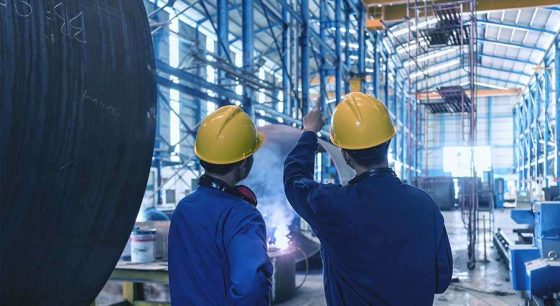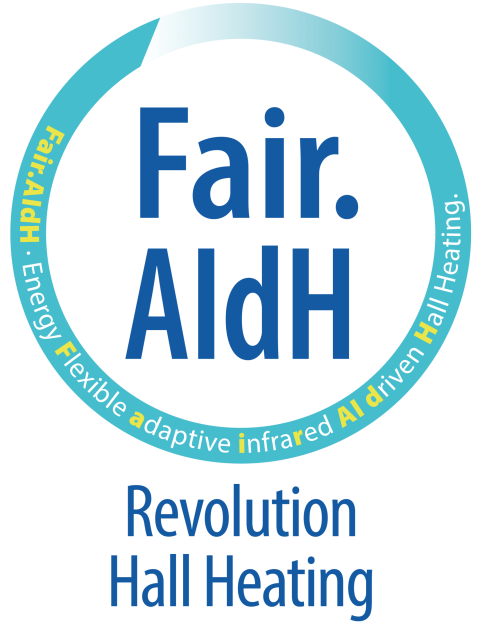Cost factor hall heating - 10 savings tips from the expert

Die erste gute Nachricht ist: Wenn Sie eine moderne Infrarot-Hallenheizung in Betrieb haben, sparen Sie von vorneherein viel Energie – und zwar ganz gleich, aus welchem Baujahr sie ist. Aktuelle Modelle sind – smart gesteuert – zwar noch extrem viel sparsamer und sie lassen sich mit erneuerbaren Energien betreiben, ein Austausch kann also wirtschaftlich sein, aber grundsätzlich stehen Sie auf einer guten Seite.
Die zweite gute Nachricht ist: Der Energieverbrauch lässt sich noch weiter senken, wenn Sie die Potenziale Ihrer energiesparenden Hallenheizungsanlage optimal ausschöpfen. Denn, wie Hallenheizungsexperte Thomas Kübler sagt: „Die sparsamste Heizung ist die, die nicht läuft.“ Da Ihre Infrarotheizung schnell wirkt, lässt sich die Temperatur im Gebäude absenken, wenn nicht gearbeitet wird und bei Bedarf Arbeitsbereiche gezielt schnell wieder erwärmen. Hierzu möchten wir Ihnen einige wichtige Tipps geben:
Tip 1: Reduce the heating times to what is really necessary.
Infrared heaters only require short heating-up times and can be switched on or off as required. You should therefore take advantage of the possibilities offered by modern digital controls. Check the time setting of your control system and adjust it to the actual working times in your hall. Incidentally, if you are not yet using a modern control system, you can retrofit this relatively easily in your existing system.
Tip 2: Check the heating zones for demand-oriented settings.
Not everyone works the same amount of time in every work area. Switch off the zones where the shift ends earlier or where no work is done on certain days.
Tip 3: Reduce the set temperature by 2 to 3 degrees.
In this way, you benefit from the special advantage of infrared heating, which ensures earlier comfort thanks to its heat radiation and the heated surfaces, e.g. the hall floor (bidirectional mode of operation). This means that the same heating quality of 18 °C air temperature of a warm air heater can be achieved at 15 to 16 °C with a highly efficient infrared hall heater. Take advantage of this benefit!
Tip 4: Check your door opening times.
Reduce these to a necessary minimum. Open doors waste a lot of energy unnecessarily. For frequent door openings, use smart software tools such as TorOff, to avoid energy losses.
Tip 5: Check the room frame for open windows and leaks.
A lot of energy can also be lost through open windows or leaking building envelopes. Unpleasant cold bridges are also created. Check your buildings and make small repairs if necessary. In this way, unnecessary energy losses can be avoided.
Tip 6: Clean the reflectors of older heating appliances.
Clean stainless steel reflectors ensure optimum infrared transmission in the working areas. If soiled, part of the heat radiation is lost through diffusion. Up to 10 percent on heavily soiled surfaces! This unnecessary consumption can be saved simply and effectively. Note: with modern top appliances such as OPTIMA plus, MAXIMA, MAXIMA E-Hybrid oder den innovativen energieflexiblen Fair.AIdH*-Hallenheizungen z. B. der Linie FUTURA there is no need to clean the reflector due to the design.
Tip 7: Think about replacing your old heating system.
Dann machen Sie bitte nicht den Fehler, bei der Hallenheizung technisch zurück auf ein konvektiv wirkendes System zu gehen (gemeint sind Systeme, die mit warmer Luft oder warmem Wasser arbeiten). Warum? Weil dies sehr wahrscheinlich ein Rückschritt in puncto Heizenergieverbrauch wäre – vom Komfortverlust erst gar nicht zu reden. Wenn Sie an eine Wärmepumpe denken, sollten Sie wissen: Die Wärmepumpe ist hervorragend geeignet, um Wärme sehr effizient auf einem niedrigen Temperaturniveau zu produzieren – ideal für die meisten Geschossbauten. In Hallengebäuden mit Deckenhöhen über 4 Meter funktioniert dieses Heizprinzip oft nicht zufriedenstellend. Zudem verlieren Sie die Option, am realen Wärmebedarf orientiert zu heizen, das heißt zu den Zeiten und in den Hallenbereichen, wo Wärme tatsächlich gebraucht wird. Die Systemträgheit der hydraulischen Wärmepumpen-Systeme sowie die Wärmeverteilung mit zusätzlich notwendigen Hilfsenergien sind wenig geeignet für die dynamischen und volatilen Anforderungen von Industrie- und Gewerbebetrieben. Angefangen bei offenen Toren bis Schichtbetrieb. Wenn Sie aufgrund des Anlagenalters und der Gesamtsituation also darüber nachdenken, Ihre Heizung zu optimieren, um den CO₂-Ausstoß und die Heizkosten zu senken, lassen Sie sich auf jeden Fall gut von ausgewiesenen Experten für energieeffiziente Hallenbeheizung beraten.
Tip 8: Find out about the new GEG-compliant hall heating technologies.
Für die Anforderungen des Klimawandels wurden eine Vielzahl an Möglichkeiten entwickelt, um den Energieverbrauch in Hallen gezielt zu senken. Bis hin zu der Möglichkeit, mit unseren innovativen E-HYBRID oder Multi-Energie-Systemen (Fair.AIdH*-Technologien) auch erneuerbare Energien sehr wirtschaftlich zu nutzen. Die jüngsten Spitzentechnologien sind in der Lage, unterschiedliche Energieformen aufzunehmen und Sie damit heiztechnisch in die karbonfreie Zeit zu beamen. Dies sind Technologien, die sehr wirtschaftlich sind, weil die Investition erschwinglich bleibt und weil sich der Verbrauch durch die vielen neu entwickelten Funktionen nochmals deutlich senken lässt. Rechnen Sie im Energiemanagement und Controlling damit, dass sich die Optimierung der Heizung mit der richtigen Technologie für Sie lohnt. Und für die Umwelt.
Tip 9: Use the possibilities of AI-supported, digital control systems.
An important factor for low-consumption heating operation is the operation of the system. Modern modular control systems such as CELESTRA or MAXTRA offer a wide range of AI-supported options for automatically running your hall heating system on the ideal line and using virtually every opportunity to save energy. Automatic switch-off when the hall doors are open, building storage, connection to the electricity exchange or integration of weather data are examples of this. The integration of an energy management system such as EMMA, which was specially developed for hall heating systems and is BAFA-listed, also ensures complete transparency of system operation through real-time analysis of each individual heating device, rapid fault detection and also provides the necessary documentation for your quality management, for example in accordance with DIN 50001. By the way, you can find a quick and easy-to-understand source of information in just a few minutes with this Explanatory video.
Tip 10: Seek advice from proven experts!
Heating halls reliably, comfortably and at the same time cost-effectively and in a climate-friendly way is anything but trivial. This is because they place completely different demands on heating technology than residential or office buildings. Make sure you contact experienced experts who are familiar with this special category of building. The hall heating specialist KÜBLER provides a lot of valuable information on www.kuebler-hallenheizungen.de available.
Und last but not least die dritte gute Nachricht: Wenn Sie die voranstehenden Empfehlungen konsequent verfolgen, realisieren Sie mit relativ wenig Aufwand werthaltige Einsparpotenziale für Ihr Unternehmen, leisten einen relevanten Klimaschutzbeitrag, erfüllen die gesetzlichen Anforderungen und profitieren von einem besonders angenehmen thermischen Arbeitsklima in Ihrem Hallengebäude.
-
Operators of indoor heating systems are also responsible for having their system serviced regularly. In addition to operational safety, there are other good reasons why maintenance should not be put on the back burner!
-
Almost all machines produce waste heat. Compressed air systems or curing ovens are at the forefront here, with enormous heat emissions. However, this usually dissipates unregulated in the building, which is annoying. On the one hand for the environment, but above all for business management. This is because a lot of energy is wasted in this way, which has to be paid for expensively elsewhere.
-
Whether in industry or in private residential construction - anyone deciding on a heating system or hall heating of the future today is faced with a lot of question marks. Which energy scenarios will actually determine the future? Which technologies will then become relevant? Is it still worth investing in fossil-fuel systems? What does the traffic light say? And taking all these questions into account, what is the best functional and economical heating solution for the hall building in the long term?
-
Climate protection remains highly relevant for the new German government. The previous climate targets are confirmed - in the full knowledge that global warming is a global problem and that the international community must work together to solve it. Climate protection should bring together economic competitiveness and social balance, with a focus on innovation. What is important is the commitment that Germany will remain an industrialized country and at the same time be climate-neutral [...]





